
Vein Finder Device Buyer Guide
Vein finder devices have revolutionized the process of venipuncture by making it easier to locate veins, especially in patients with difficult vascular access. These devices use advanced light technology to provide a clear view of the veins beneath the skin, making procedures like phlebotomy, IV insertion, and other medical applications more efficient and less stressful for both healthcare professionals and patients.
- How Portable/Handy Is the Device?
- What Light Technology Does the Device Use?
- Does the Device Offer Hands-Free Operation?
- Does It Come in Black?
- Does It Have a Universal Charging Port?
- Is the Device Rechargeable or Does It Use Replaceable Batteries?
- Does It Show Battery Status?
- How User-Friendly Is the Interface?
- Is the Product from a Certified Manufacturer?
- Where Is the Manufacturer Located, and Can They Provide Warranty Support?
- What Is the Cost?
Key Questions to Ask When Buying a VeinFinder Device
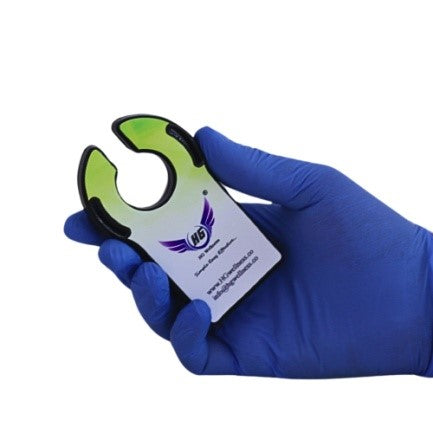
How Portable/Handy Is the Device?
The portability of a vein finder device is crucial, especially if you're using it frequently or in different locations. Smaller devices are often better because they are easier to handle and manoeuvre during procedures. Consider the dimensions and weight of the device—lighter and more compact models are generally preferable, as they reduce fatigue and make it easier to position the device on the patient's skin.
What Light Technology Does the Device Use?
Instead of focusing solely on the number of LEDs, check the light technology and wattage per LED. A device with fewer, more powerful LEDs (e.g., 6 LEDs at 2-3 watts each) will typically provide better vein visualization than one with a higher number of less powerful LEDs (e.g., 30 LEDs at 0.5 watts each). The total wattage and the quality of the light are more important than the sheer number of lights, as scattered light from too many low-wattage LEDs can diminish the clarity of the vein image.
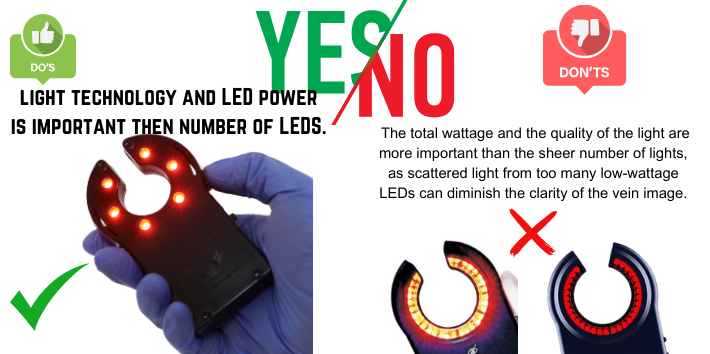
Does the Device Offer Hands-Free Operation?
Hands-free operation is a valuable feature that allows you to focus on the procedure without needing to hold the device in place. Look for devices with an occlusion slot that can accommodate hook-and-loop belts, enabling you to secure the device to the patient’s arm. This not only frees up your hands but also ensures consistent positioning, improving the accuracy of vein visualization.
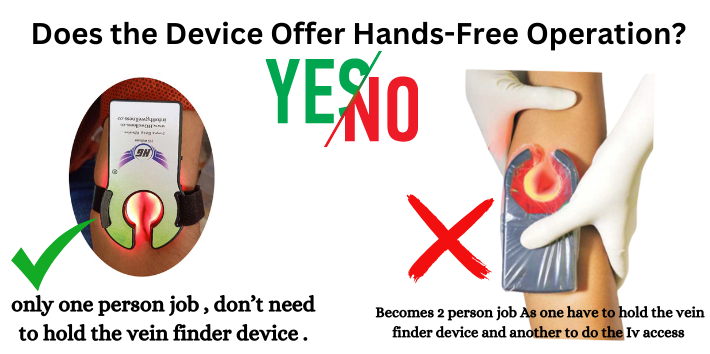
Does It Come in Black?
Surprisingly, the colour of the device matters. A black, opaque device is scientifically advantageous because it prevents light from scattering through unintended parts of the device, ensuring that the light is focused only on the vein visualization area. This enhances the effectiveness of the device, leading to clearer vein images.
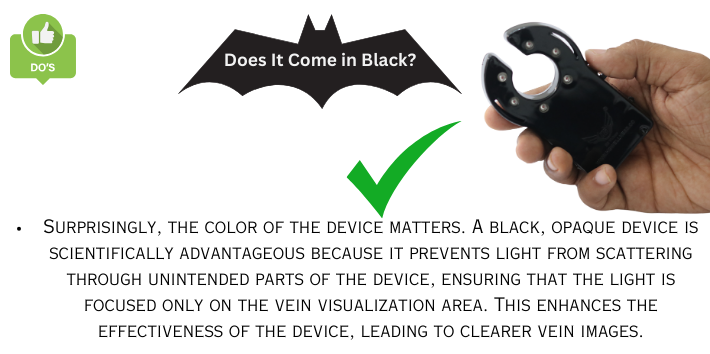

Does It Have a Universal Charging Port?
For healthcare professionals on the go, or even in a stationary environment, it’s inconvenient to carry different chargers for each device. A vein finder with a universal charging port, like USB, ensures that you can use the same cable you use for your other devices, reducing clutter and making it easier to find a replacement if needed.
USB charging port
Specialize charging port which is not available universally

Is the Device Rechargeable or Does It Use Replaceable Batteries?
Opt for a rechargeable vein finder device rather than one that uses AA or AAA batteries. Replacing batteries frequently can be both costly and time-consuming. Rechargeable devices offer better performance and eliminate the hassle of constantly having to replace batteries.
Rechargeable battery
AA/AAA battery no – not rechargeable
9v battery – not rechargeable
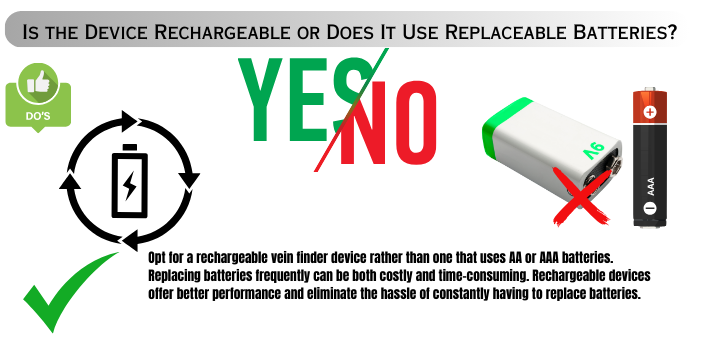
Does It Show Battery Status?
A good vein finder device should have a battery indicator, such as a light that changes color (e.g., from red to green) to show when the device is fully charged. This feature ensures that you’re never caught off guard with a dead battery during a procedure.
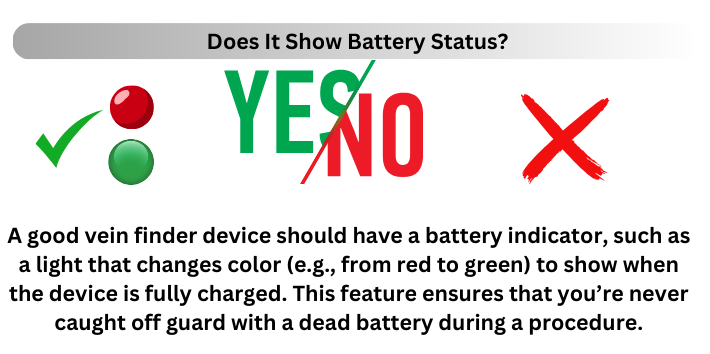
How User-Friendly Is the Interface?
The interface of the device should be simple and intuitive. Basic slides switch for turning the device on and off, along with a separate control for adjusting the intensity are ideal. Avoid devices with overly complex controls or multifunction buttons that can lead to confusion, especially during time-sensitive procedures.
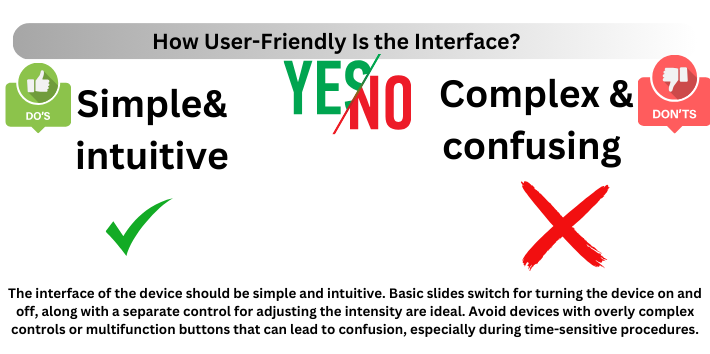
Is the Product from a Certified Manufacturer?
Ensure that the device is from a certified manufacturer, preferably with FDA registration or other relevant certifications. This guarantees that the device meets safety and quality standards, giving you peace of mind about its reliability.

Where Is the Manufacturer Located, and Can They Provide Warranty Support?
Before purchasing, check if the manufacturer offers a warranty and if they have a presence in your country. It’s okay if the manufacturer is located abroad, but they should have a service team or warehouse in your country to provide timely support and warranty services if needed.
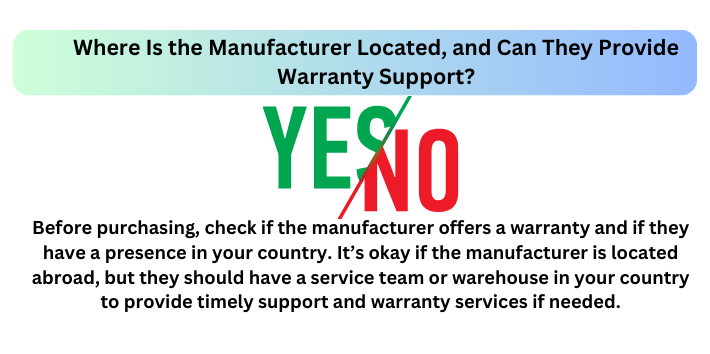
What Is the Cost?
Finally, consider the cost of the device. While a high-quality vein finder is a worthwhile investment, it should be reasonably priced within your budget. Avoid overspending on a device that costs more than your monthly salary unless it offers significant benefits that justify the expense.
By carefully considering these factors, you can choose a vein finder device that best suits your needs, ensuring that you have a reliable tool to improve patient care and enhance your medical practice.
Similarly , low cost and low price product may appeal initially due to its low cost but cheap product tends to have costly impact as due to low quality you have to buy it more than one time and end of the day it cost you more than costly unit. So always use the product that fulfils your use case and then only follow your budget for the purchase